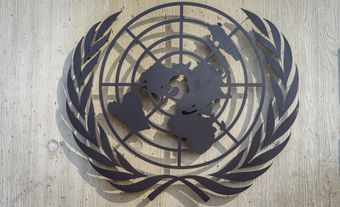This article was originally published in Maclean's Magazine on January 30, 1995
Kobe Earthquake
Bridges, train trestles and elevated highways collapsed, sending hapless passengers plummeting to their deaths. Apartment buildings crumpled and fell, crushing terrified occupants still huddled in their beds. Next, fires raged through the ruined city, incinerating people trapped under towering heaps of rubble and sending dazed survivors scurrying for safety into smoke-filled, buckled streets. A vision from hell? That is how many residents of Kobe described the earthquake that struck central Japan at 5:46 a.m. on Jan. 17, rumbling across Honshu Island from the Pacific Ocean to the Sea of Japan. "Our world exploded around us here," said Dennis Doucet, a former Vancouver-area resident teaching in Kobe. "It's just as though a bomb had gone off." But as calamitous as the predawn tremor was, the fact that it occurred before the morning rush hour almost certainly spared many thousands of additional lives. "If the earthquake had occurred a couple of hours later, it would have been a massive, chaotic disaster," said Yoshiaki Kawata of Kyoto University's Disaster Research Institute.
As it was, the 20-second jolt took a heavy toll. More than 4,900 people were killed, with another 26,000 injured and 300,000 left homeless. Most of the casualties and damage occurred in Kobe, an international port city of 1.4 million people, including some 1,100 Canadians. The quake also shook Osaka, Japan's second-largest city, and the ancient capital of Kyoto. Adding to the anguish of survivors was a government warning that a strong aftershock was likely to rock the quake zone within a month. After surveying the devastation in Kobe, a clearly shaken Prime Minister Tomiichi Murayama said: "I have seen nothing like it. This is far beyond anybody's imagination."
In fact, the Kobe quake was Japan's worst natural disaster since the 1923 Great Kanto Earthquake, which claimed 140,000 lives in Tokyo and Osaka. Since then, the island nation has invested billions of dollars in early warning systems and sophisticated construction techniques aimed at ensuring that 50-storey skyscrapers survive even the biggest shocks. But with nearly 10,000 buildings in Kobe in ruins, and twice that many severely damaged in the quake zone, construction experts were forced to wrestle with the question of why the destruction had been so dramatic. During a parliamentary session in Tokyo, Murayama pledged a major revision of the nation's disaster policies. Among other things, the government will upgrade its capacity to forecast earthquakes and analyze collapsed buildings and roads so the country can make its structures more resilient to tremors. "It is imperative that we rethink and restructure our disaster relief policies for the whole of Japan," he said.
Experts had been warning for several weeks of a major earthquake in central Japan, one of the world's most active seismic hot spots. Nearly 1,000 tremors of varying intensity ripple through the country's islands each day, and more than 160,000 Japanese have been killed by quakes since the turn of the century. Last year alone, there were several quakes bigger than the one in Kobe, which registered 7.2 on the open-ended Richter scale. But those mostly struck sparsely populated areas of the north. Indeed, when a quake measuring 7.5 on the Richter scale hit the city of Hachinohe in northern Japan on Dec. 28, only three people were killed.
The Kobe quake also heightened fears in the Tokyo area, which has been struck by major tremors roughly every 70 years over the past three-and-a-half centuries - the last time in 1923. Japan's capital region, home to some 30 million people, is situated on the Kanto Plain, where three active tectonic plates are gradually converging. Experts predict that the level of death and destruction from a big quake in Tokyo would far surpass that in Kobe. Much of the capital's industry has been built on landfill that would likely liquify during a major tremor. In addition, the city is honeycombed by underground gas lines that would rupture and feed fires; its maze of narrow, congested streets would hamper rescue efforts; and many of its older high-rise buildings have not been quake-proofed. Using a computer simulation, the Tokyo Fire Defense Agency predicted last week that an earthquake as intense as the Kobe tremor would kill or injure some 67,700 people in the capital region, cause 1,000 fires and destroy 1.84 million square yards of property in one hour.
More than 72 hours after the quake rocked Kobe, most residents were still without electricity, gas and water. Fires continued to burn and new blazes broke out in damaged buildings, sparked by power surges and, in several cases, by rescuers digging for survivors near broken gas pipes. City officials warned repeatedly of the danger from aftershocks and poor sanitary conditions. And some experts predicted that reconstruction would take months, if not years, at an estimated cost of $85 billion.
Complaining of a slow government response to the crisis, many survivors fled the city on foot and in cars, clogging secondary roads connecting Kobe with nearby Osaka. Hundreds of thousands of others packed into evacuation centres to escape the winter chill, the strain of their ordeal clearly showing. Outside one such centre, a school gymnasium, an elderly man stood wrapped in a blanket, tears running down his cheeks. "This is like after the Second World War," he said. "We suffered so much. I am too old to suffer the same fate once again."
Maclean's January 30, 1995

 Share on Facebook
Share on Facebook Share on X
Share on X Share by Email
Share by Email Share on Google Classroom
Share on Google Classroom


